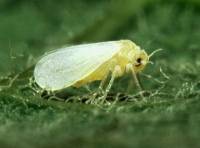This is an old revision of the document!
Table of Contents
Group 5
<html><font size=6 face=“Arial”>Sex ratio shift as an invasion strategy</font></html>
Wiki site of the practical exercise of the IX Southern-Summer School on Mathematical Biology.
Here you will find the exercise assignment and the group's products.
If you are a group member login to edit this page, create new pages from it, and upload files.
Introduction

Invasions of whitefly B. tabaci (left imagem, from Wikipedia) destroy plantations in the south of USA, Australia, China, and other countries. Several mechanisms have been isolated and tested in an experimental setting to reveal their contribution to invasion.
The whitefly species is haplodiploid, i.e., fertilized eggs generate diploid females and unfertilized eggs generate haploid males.
Twelve different biotypes of whitefly are already reported. It is possible to distinguish between them through phylogenetics analysis. One of the biotypes, referred to as 'B biotype', native from Mediterranean asia, has been reported invading rapidly the worldwide populations of whitefly of other biotypes. B biotype entered in both China and Australia in the 90s, where the native biotypes are ZHJ1 and AN, respectively. Interestingly, this system showed asymmetric coupling behaviors. Mating experiments between B and ZHJ1 and between B and AN indicated that neither could interbreed to produce fertile female offspring.
Liu et al. detected significant changes in sex ratio in both the indigenous and alien populations in both regions. In China, when populations of either B or ZHJ1 occurred alone, B usually had female ratios of 60~70%, which were higher than the 50~60% female ratios in ZHJ1. Very similar results also happened to AN biotype. This difference was even higher when the two different biotypes coexisted during the invasions.
Then, the same group, decided to reproduce this behavior in controlled environments. Their results included a B biotype domination in mixed cohorts: “The relative proportion of B increased steadily with time and had totally supplanted ZHJ1 after 225 days.” And also, it confirms the data of sex ratios in nature: “Each cohort was initiated with 50% females, and divergences in sex ratio among the different cohorts occurred with time. In cohorts with B only, the female ratio increased in the first 50 days and remained at 60~70% thereafter; in cohorts with ZHJ1 only, the female ratio remained at 50~60% throughout. In contrast, the female ratio of B in the mixed cohorts increased and reached 70~80% from days 50 to 150 when displacement was actively taking place, while that of ZHJ1 decreased to mostly 30~40%.” And once again, very similarly happened to AN biotype.
Scientists noticed some interference behavior in whiteflies was acting as a mechanism to change sex ratios within biotypes. Although identification of the progeny produced using nuclear DNA markers detected no hybrids, demonstrating reproductive isolation between B and ZHJ1 and between B and AN, effects inter-biotypes still happened, as it was showed that B interacting with an indigenous biotype could increase production of female progeny by increasing its frequency of copulation, and at the same time could reduce the production of female progeny by the indigenous females through reducing copulation by the latter. This manipulation happened when two males from different biotypes and a female of a given biotype were placed together, the female was frequently courted by both males and courting and copulation could be interrupted by the second male - literally a gooseberry.
Assignment
Propose a mathematical model to investigate the strategy of sex-ratio shift in whiteflies caused by Rickettsia interference, the possible symbiotic mechanism discussed above. Explore the consequences of it to the bacteria invasion speed and the persistence of whiteflies.
Questions & Suggestions
- Can you come up with a quantification of the invasion speed in your model? How does it behave with the biasing of sex? Is there a ratio which provides the highest speed?
- What are the consequences of infection by Rickettsia to the persistence of whitefly species? Can high biased sex-ratios extinguish the population of whiteflies?
- Can this suggested mechanism explain an equilibrium at an unbalanced sex ratio in the population?
- Which parameters (and how) interfere in the population equilibrium sex ratio?
References
Anna G. Himler, Tetsuya Adachi-Hagimori, Jacqueline E. Bergen, Amaranta Kozuch, Suzanne E. Kelly, Bruce E. Tabashnik, Elad Chiel, Victoria E. Duckworth, Timothy J. Dennehy, Einat Zchori-Fein, Martha S. Hunter.Rapid Spread of a Bacterial Symbiont in an Invasive Whitefly Is Driven by Fitness Benefits and Female Bias. Science, 2011. Vol. 332, Issue 6026, pp. 254-256. https://science.sciencemag.org/content/332/6026/254.
A short article about sex-ratio shift in the light of evolution and natural selection: https://evolution.berkeley.edu/evolibrary/news/110401_whiteflies.
